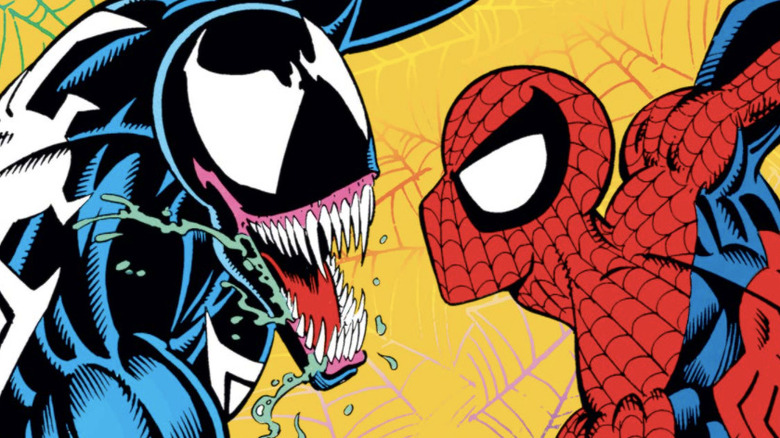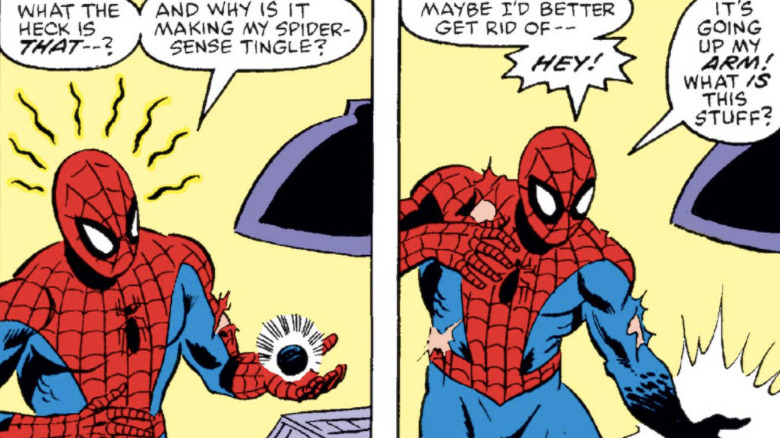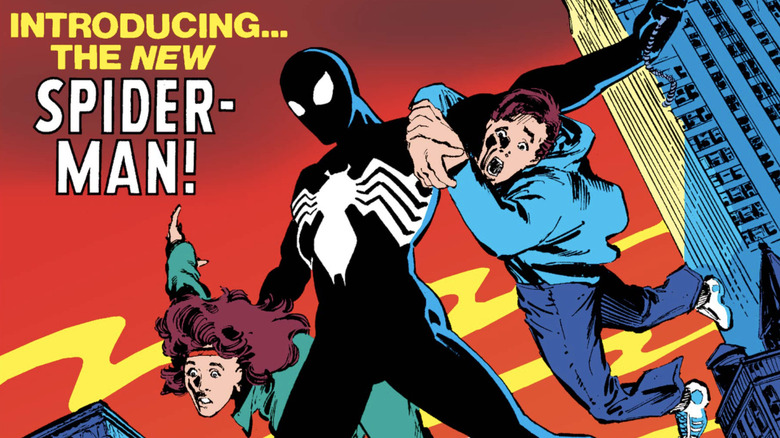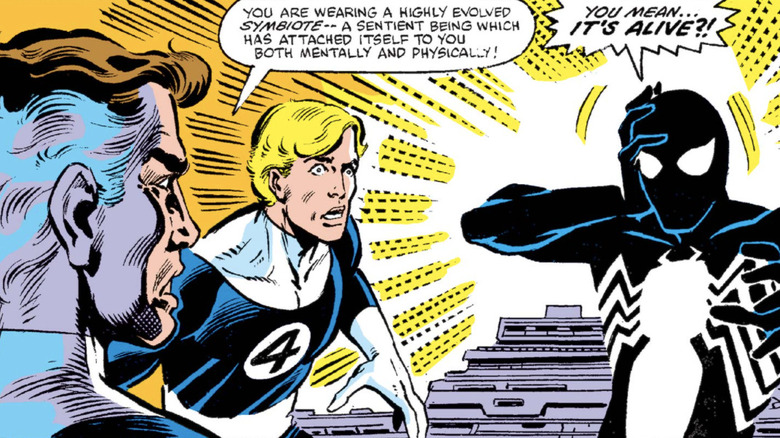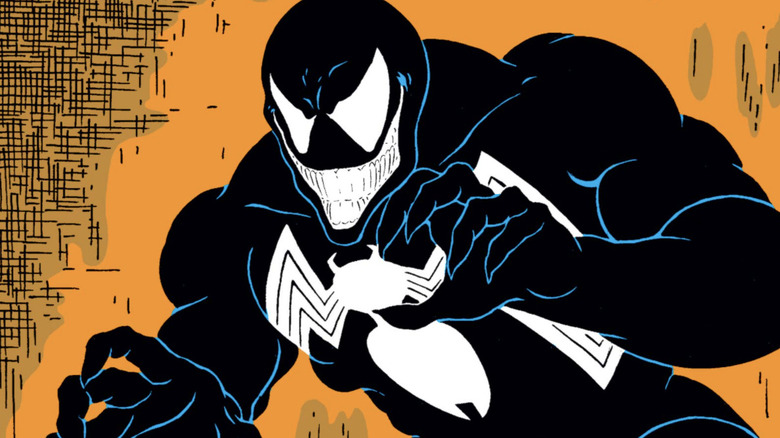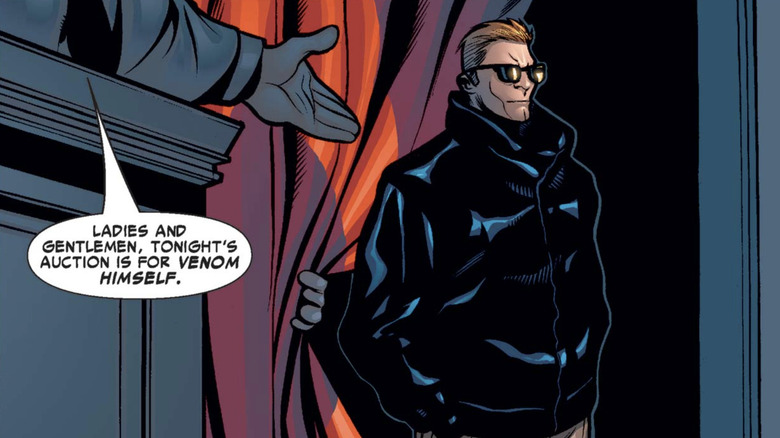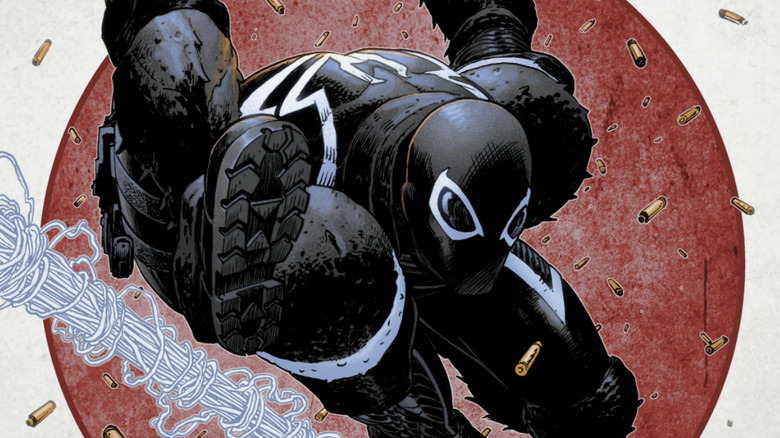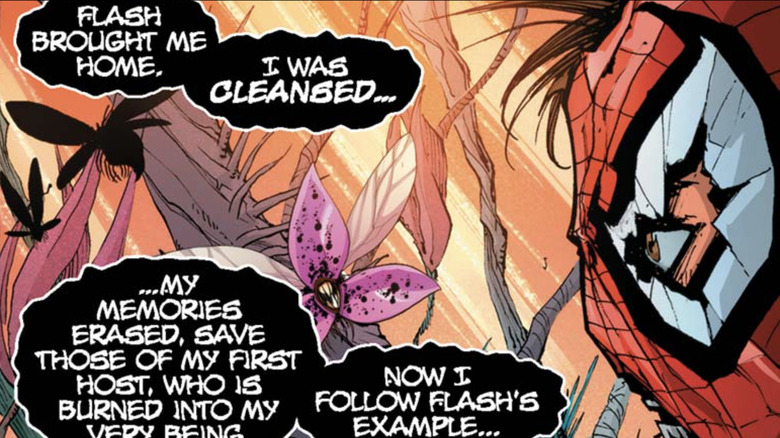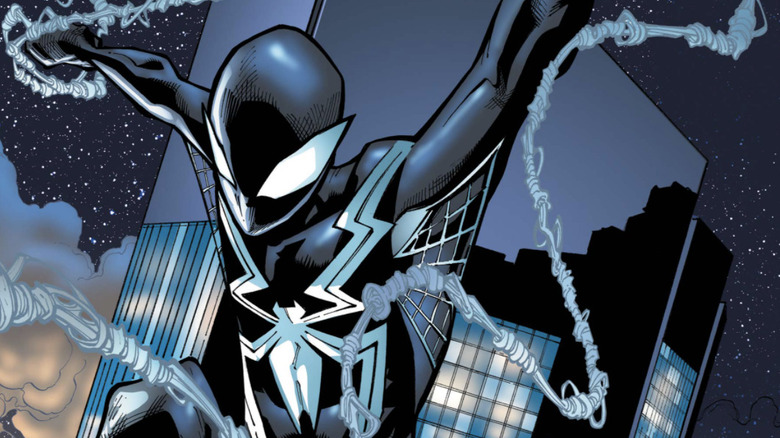The History Of Venom's Relationship With Spider-Man Explained
Spider-Man has one of the more distinguished and varied rogues' galleries in comic book history, a villainous roll call that includes everyone from the Green Goblin to Doctor Octopus and Kraven the Hunter. One, however, stands above all the rest. The alien symbiote called Venom has been a thorn in Peter Parker's side since the 1980s, and still ranks to this day among the webslinger's primary nemeses, particularly on the occasions when he's bonded to human host Eddie Brock. While he showed up in the much-maligned "Spider-Man 3," Venom has more recently become the star of his own film franchise — one that, to this point, has not involved Spider-Man. The two are still indelibly linked together, however, and no matter how many adventures he has on his own, Venom will always be considered Spider-Man's deadliest enemy.
So it might come as a shock to you (especially if you haven't been following Marvel Comics over the years) that things are far more nuanced than that. In fact, Spider-Man and Venom have a relationship that can best be described as "love/hate" — theirs is a story of attachment and loss, of connection and rejection. In some ways, it can be seen as a twisted romantic allegory, a warning about what can happen when love turns to loathing, but it also, surprisingly, has a happy ending (at least for now). What's the true history between Spider-Man and Venom? It's time to find out.
Meet-cute on Battleworld
The Venom symbiote was first introduced in 1984 as part of the line-wide Marvel Comics crossover (or, if you prefer, glorified Mattel commercial) known as "Secret Wars." The storyline sees numerous heroes and villains from the Marvel Universe kidnapped into space by a godlike alien entity called the Beyonder, who deposits them on a planet he dubs "Battleworld" and demands they fight one another. In the eighth issue, Spider-Man, needing a new costume, is directed toward an alien machine that can build him one. Of course, he picks the wrong machine, and is introduced to a small black ball of unknown substance and origins — which quickly covers his body and takes the form of a costume, giving Spider-Man a new look for the first time in the character's history (and, presumably, giving Mattel another reason to make new Spider-Man toys).
The idea for the costume change reportedly came from a story pitch from a fan that Jim Shooter, Marvel's editor-in-chief at the time, had received in 1983. He didn't like the story, but he liked the idea of changing Spider-Man's costume. When the deal with Mattel came along and Marvel decided to do "Secret Wars," in which several major characters would disappear and come back with changes to their appearance (which would lead to a demand for new toys that matched the new versions of the characters), Shooter jumped at the chance to make the change. He had no idea that he'd just (literally) created a monster.
Sharp-dressed man
Technically, Spider-Man's black suit predates "Secret Wars" by more than six months. Spider-Man mysteriously vanishes from Earth at the end of "Amazing Spider-Man" #251 in April 1984, but returns at the start of the very next issue wearing the black costume, with the entirety of "Secret Wars" having occurred between the two issues. For the rest of the year, the events of "Secret Wars" unfolded retroactively in the pages of the crossover book, while Spider-Man, wearing the black suit, continued to do his usual stuff in his own comic — things like fighting supervillains, dating the Black Cat, and dropping out of college. He occasionally considered how weird it was that his new suit responded to his every thought, but he didn't have time to worry about it. Of course, he might have made time if he knew what the readers knew: that the suit had started enveloping Peter while he slept, dragging him around New York to fight crime as Spider-Man without his knowledge.
Eventually — after realizing the suit had powers he didn't even know about, and after it had displayed increasing reluctance to leave his body — Spider-Man finally took it to be examined by Reed Richards of the Fantastic Four, who discovered the costume's true nature.
Revelation and rejection
It's not every day a super-scientist tells you that the costume you've been wearing to protect your identity while fighting criminals is not only a sentient alien, but a sentient alien that is trying to permanently bond with you. Spider-Man's "get it off me, get it off me" reaction is perfectly understandable from a human point of view. For the symbiote, however, it was rejection, and rejection led to bitterness and hatred.
Spider-Man managed to free himself from the symbiote with the help of the Fantastic Four, who used its weaknesses against sound and fire to trap it in a containment unit for future study. Eventually, however it escaped, and managed to trick Spider-Man into putting it back on by disguising itself as a more traditional blue-and-red costume. It then attempted to forcibly bond with him, an effort that Peter was only able to thwart by standing directly beside a set of massive church bells, exposing both the symbiote and himself to their ear-shattering resonance. The sound forced the symbiote to relinquish its hold on its unwilling host, who had fallen unconscious and could potentially have been killed by such close proximity to the bells. However, despite Peter's rejection, the symbiote saved his life by dragging his body away from the murderous noise, foreshadowing the troubled future of their relationship — even at this early stage, there was love mixed in with the hate.
Eddie Brock, rebound host
It would be three years before the symbiote was seen again, but when it came back, it came back quite literally with a vengeance. The final page of "Amazing Spider-Man" #299, published in April 1988, introduced the character now popularly known as Venom, though he didn't have knives for teeth or the long, slavering tongue quite yet. After being separated from Spider-Man in the church, the symbiote had found a new host — Eddie Brock, a former journalist whose life and career had been ruined, in his mind, by Spider-Man. Preparing to commit suicide, the Catholic Brock went to a church to pray for forgiveness. Instead, he found the symbiote, which bonded to him — not just physically, but emotionally, through their mutual hatred of Spider-Man. Naming themselves Venom, Brock and the symbiote instantly became the webslinger's deadliest foe. Not only did they not set off Peter's early warning spider-sense, but they knew his true identity, and were able to threaten his loved ones.
While Spider-Man was never able to defeat Venom in direct combat, he survived the late '80s and early '90s largely due to trickery. In their first meeting in "Amazing Spider-Man" #300, Peter uses his knowledge of how the symbiote works to defeat Venom, while in "Amazing Spider-Man" #317, he pretends to take the symbiote back, revealing that the alien still secretly wants to be with Peter, not Brock — and the symbiote's attempt to break its bond with Brock knocks them both unconscious.
The enemy of my enemy
Venom's next two major appearances set up a major shift in his relationship with Spider-Man, which would see them reluctantly team up in the face of a greater danger. "Amazing Spider-Man" #333 features the apparent death of the Venom symbiote at the cancerous hands of the villain Styx. Depowered, Eddie Brock is imprisoned for his crimes and placed in a cell with a serial killer named Cletus Kasady. The symbiote, however, isn't dead, and it soon seeks Eddie out and breaks him free. They continue to menace Spider-Man, this time fighting him on a deserted island. Peter tricks Venom for a third time by faking his own death, escaping the island while Brock and the symbiote relax on the beach, content in the knowledge that their quest for revenge is complete.
Venom might have lived out the rest of his days on that island in peace (with the occasional interruption from Darkhawk) if not for the spawn the symbiote had left behind in Eddie's cell. This second symbiote would bond with Kasady, transforming him into the murderous villain known as Carnage. For all Venom's hatred of Spider-Man, he's has always had a code of honor that prevents him from killing the innocent, or allowing innocent deaths to occur. Carnage's murders were indiscriminate, however, and when Spider-Man asked for Venom's help in stopping the killing spree, Venom agreed. It was the first time they would team up to take down Venom's crimson "son," but certainly not the last.
The truce
It wasn't until 1993 that the tentative alliance between Spider-Man and Venom graduated into a full-fledged cessation of hostilities. After all, Spider-Man had gotten Venom thrown back in prison immediately after taking down Carnage for the first time, and when Venom inevitably escaped, he was once again out for Peter Parker's blood. The story that followed involved both Peter's long-lost parents, recently returned (they would turn out to be imposters, but not for another year) and Eddie Brock's ex-wife, Anne Weying. "Amazing Spider-Man" #375 was billed as "the final confrontation," as Spider-Man battled Venom in an abandoned theme park, determined to stop him for good. Anne, who had helped Spider-Man locate her former husband, arrived on the scene to try and help, but ended up nearly being crushed by a falling ferris wheel. Venom and Spider-Man were forced to join forces to save her, and afterward, Anne helped Venom realize that Spider-Man regularly saves innocent lives. "So if we killed him now," Venom reasoned, "all the innocents he might save in the future — would die!"
This revelation finally led to a truce between the two, which Venom succinctly summed up by saying "you don't come after us, we won't come after you!" He then swung away into his own limited series, "Venom: Lethal Protector." It was actually Spider-Man who ended up breaking the truce in that series when he went hunting for the escaped Venom, but by the end, the two were working together again, with Venom having completed his transformation into a hero.
Old habits
Venom spent a solid decade (from the mid-90's to the mid-2000s) hanging around the Marvel Universe as a popular anti-hero, starring in numerous limited series and finally getting his first ongoing title in 2003. Over this period, he had more adventures with Anne Weying, who spent some time as She-Venom, attempted to train a new symbiote/host entity called Toxin, and revealed that the Venom symbiote was the only thing keeping the cancer inside Eddie from killing him. Eddie, meanwhile also started to question whether being bonded to the symbiote was influencing him towards violence, a theory seemingly confirmed by his eventual slide back into villainy, and specifically hatred for Spider-Man — the truce between the two officially ended when Anne commited suicide, and Venom believed Spider-Man was the cause.
In 2004, the symbiote went full villain once again, though Eddie Brock did not. Having experienced a religious re-awakening after watching "The Passion of the Christ" (yes, really), Brock finally gave up being Venom, selling the symbiote at a supervillain auction. The symbiote first possessed the son of the mob boss who bought him before finding a more suitable host in Mac Gargan, aka the Scorpion, and remained an antagonist of Spider-Man and various other Marvel heroes for the remainder of the 2000s, a status quo that continued through events like "Secret Invasion," "Dark Reign," and "Siege."
Agent Venom
While the symbiote's time with Mac Gargan represented a regression into old habits, its story was about to take a very different (and very strange) turn. From 2011 to 2017, Venom's host was a very different Spider-Man character — Flash Thompson, former Spider-Man admirer and Peter Parker bully, who eventually became a hero in the military, but also lost his legs. When the government decided to put the Venom symbiote to use, it gave it to Flash, allowing him to walk again and transforming him into the heroic Agent Venom. The symbiote was not bonded to Flash — he was only allowed to use it for 48 hours at a time — and their relationship was an openly antagonistic one, with the symbiote taking any opportunity to seize control and perform monstrous acts of violence.
Most of Agent Venom's story doesn't directly involve Spider-Man, but their paths crossed in unusual fashion in the pages of "Superior Spider-Man." Written by Dan Slott, the premise of this title involved a mind swap between Peter Parker and his longtime nemesis Otto Octavius, aka Doctor Octopus, who continued to fight crime as Spider-Man while in his rival's body. As Spider-Man, Octavius forcibly extracted the symbiote from Flash and became host to it himself — calling himself the Superior Venom. In a fascinating reversal, however, the symbiote sensed something wrong with its old flame. While it briefly tasted freedom by taking full control of Spider-Man's body, it was expelled by a remnant of Peter's mind and returned willingly to Flash.
Cleansed by the Klyntar
Things didn't get any less weird for Agent Venom after dealing with the Superior Spider-Man — in fact, he ended up going to space and joining the Guardians of the Galaxy. While his adventures with the Guardians don't directly involve Spider-Man, they do include a story that completely redefined the relationship between the two, when Venom returned to his home planet.
As penned by Brian Michael Bendis, this story introduced Klyntar, home of the symbiote hive. Originally a species of conquerors, the Klyntar had repented of their ancient evil ways, seeking instead to become a force for good. They formed the Agents of the Cosmos, an organization of symbiotes bound to worthy hosts who were dedicated to fostering peace and justice throughout the universe. Some symbiotes, however, had been corrupted by their hosts, and the Venom symbiote was one of these. Upon its arrival back home, the Klyntar were able to cleanse it, a process that included a near-total memory wipe of its previous hosts. As a result, when Agent Venom returned to Earth and once again encountered Spider-Man, it had no memory of him, and thus no reason to hate him. The symbiote even apologized to Spider-Man and expressed a desire to one day earn his forgiveness. Not sure anyone saw that coming back in 1985.
Reconciliation
If the Klyntar memory wipe set the stage for a reconciliation between Venom and Spider-Man, the events of 2018 and 2019 brought their relationship full circle. By that point, the Venom symbiote had been separated from Flash Thompson, and after a brief fling with an ex-soldier named Lee Price, it became bonded to Eddie Brock once again, and they were once more the star of a "Venom" ongoing series. While the symbiote didn't remember their mutual hatred of Spider-Man, Brock did, and for a while it seemed as though they might fall back into their previous rivalry. Fortunately, Flash (having taken up the mantle of Anti-Venom, formerly held by Brock himself) was there to keep the peace between them.
When Carnage bonded with legendary Spider-Man nemesis Norman Osborn to become the Red Goblin, Spider-Man and Venom, as usual, teamed up to oppose him. In order to defeat Red Goblin, Brock willingly gave up the symbiote to Spider-Man, who donned it again in "Amazing Spider-Man" #800. After the Red Goblin's defeat, the symbiote was transferred peacefully back to Brock. It was a sequence of events that truly demonstrated how far the two characters had come. And as if to reinforce it, during the 2019 event "Absolute Carnage," the symbiote itself convinced Brock to join forces with Spider-Man yet again — a story that ended with Eddie Brock, who had sworn to kill Spider-Man on numerous occasions, actually giving his old enemy a hug.
